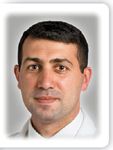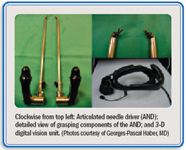Article
Novel driver is economic solution for laparoscopic suturing
Use of a novel articulated needle driver in combination with a three-dimensional imaging system appears to offer a viable method for facilitating suturing in laparoscopic urologic surgery.



The study involved five expert, five intermediate, and five novice laparoscopic surgeons. After practicing for 20 minutes with the AND with and without the 3-D vision system, each surgeon performed two tasks in a pelvic trainer using the AND, the AND with the 3-D vision system, or the straight CND. The first task involved placement of one sagittal, one coronal, and one oblique running suture with knot tying in the horizontal plane. The second task required creation of a running urethrovesical anastomosis in a rubber model.
Comparisons were made within each group for the following outcomes: total time needed for suturing, knot-tying time, time to accomplish the urethrovesical anastomosis, precision, and accuracy.
In all groups, precision and accuracy improved significantly using the AND versuss the CND. Among the intermediate and novice surgeons, precision and accuracy improved slightly more using the AND with the 3-D vision system compared with the AND alone, but the difference was not statistically significant.
Among the novice surgeons, mean accuracy using the CND was 54.3%. It increased to 77.3% using the AND and was 78.6% using the AND plus 3-D vision. Corresponding values for precision using those three techniques were 55.6%, 85.6%, and 88.6% in the novice surgeon group.
Among the surgeons with intermediate laparoscopic experience, precision was 70.9% using the CND, increased to 88.6% using the AND, and was 89.5% using the AND and 3-D vision. Accuracy was 59.4% with the CND, 81.3% with the AND, and 84.6% with AND plus 3-D vision.
"These results achieved using the AND are excellent, particularly for surgeons who are novices to laparoscopic surgery," Dr. Haber said.
The expert laparoscopic surgeons achieved 81.3% precision and 69.7% accuracy using the CND. With the AND, those rates improved to 88.4% and 85.4%, respectively. Precision and accuracy with the AND and 3-D vision were 86.5% and 86%, respectively, in the expert group.
Newsletter
Stay current with the latest urology news and practice-changing insights — sign up now for the essential updates every urologist needs.
















